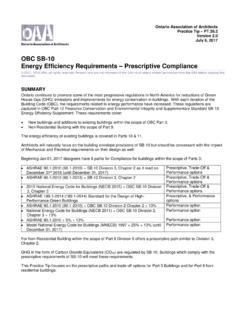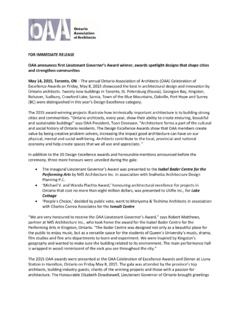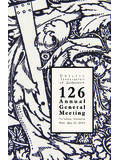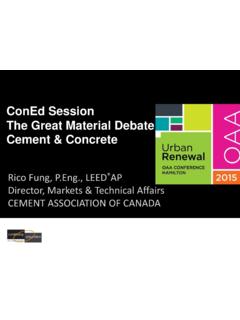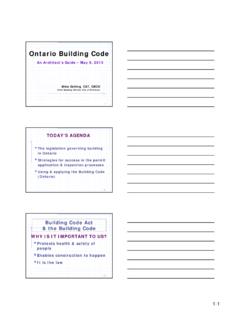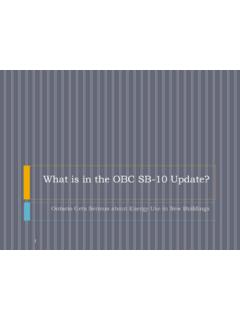Transcription of Guide to Project Closeout Procedures original
1 A Guide to Project Closeout ProceduresA joint publication of 1 The Ontario General Contractors Association and the Ontario Association of Architects gratefully acknowledges the assistance of the following in the development of this Guide (the Guide ): Mr. Tom Falls McKay-Cocker Construction Ltd. Mr. Jake Thomasen Melloul-Blamey Construction Inc. Mr. John Clinckett Construction Specifications Canada Mr. David Molyneux Integra Project Services Ltd. Mr. Allan Youmans Matheson Constructors Inc. Mr. Chris Fillingham Stantec Architecture Ltd., Architects Mr. Craig Lesurf Vanbots, a division of Carillion Construction Inc. The Ontario General Contractors Association ( OGCA ) and the Ontario Association of Architects ( OAA ) do not accept any responsibility for mistakes or omissions in this Guide . The OGCA, OAA and the authors are not engaged in rendering legal, accounting or other professional advice. If such legal advice or other expert assistance is required, the services of a competent professional should be sought.
2 This Document may be used as a reference in combination with OAA/OGCA Document , dated December 12, 2007 - RECOMMENDED Procedures CONCERNING SUBSTANTIAL PERFORMANCE OF CONSTRUCTION CONTRACTS AND COMPLETION TAKE-OVER OF PROJECTS Enquiries should be directed to: Ontario Association of Architects Ontario General Contractors Association 111 Moatfield Drive 703 6299 Airport Road Don Mills, Ontario Mississauga, Ontario M3B 3L6 L4V 1N3 Phone: (416) 449-6898 Phone: (905) 671-3969 Fax: (416) 449-5756 Fax: (905) 671-8212 Published by Ontario General Contractors Association and Ontario Association of Architects November 2010 2 PREFACE Getting a construction Project to the Milestones of Substantial Performance of the Work and then to Completion and Turn Over are some of the most difficult challenges to be met during the construction of a facility. This process involves thousands of actions performed by hundreds, if not thousands, of individuals from all facets of the construction chain including manufacturers, distributors, suppliers, subcontractors, sub-subcontractors, contractors, construction managers, consultants, allied professionals, Project managers, developers, owners, government, end users, etc.
3 While the obligations of each are often detailed in the Project documents and various contracts, they are not always coordinated as well as they could be, which can lead to costly and delays in achieving Substantial Performance and then total completion. If you can t get it done, you can t reach Substantial Performance. If End Users are not able to use the facility as intended, then everybody has to spend more time and money to help wrap it up and everybody s monies are delayed. The following is a Guide to Project Closeout Procedures . It has been created to assist in the process and make things go smoother, and as a reminder that the last 3% of the Project is often taking at least 15% of the effort. It takes a team effort. So let s all try to work together to make the last 3% of the Project 3% or less of the effort! This Guide has been produced by the Ontario General Contractors Association, the Ontario Association of Architects and in cooperation with industry stakeholders representing owners, contractors and electrical and mechanical contractors.
4 The primary purpose of this Guide is to introduce the reader to best practices which will expedite and simplify the takeover of a Project by its owner from the contractor who managed its construction. The Guide contains recommended practices following the principles and methods for successfully completing the takeover process efficiently for all parties. The use of these practices will improve the process of Closeout and takeover and reduce the problems associated with this stage of the Project . This Guide was prepared because members of the construction industry recognize that the closing out of construction projects has been getting more and more difficult. It is in the interests of the whole construction industry and owner to make the takeover of construction projects by owners more time effective and less stressful for all participants. In our discussions, certain themes came to the surface time after time of what could help ameliorate the situation: Timeliness Takeover issues need to be addressed before the tendering of the Project , for example by the owner / consultant communicating expectations in the bid documents, and then addressing them from the first site meeting onward and at every subsequent site meeting.
5 Deficiencies need to be addressed as they are observed. The value of repairing deficiencies must be included as deductions in regular 3 Progress Draw calculations and applications for each trade. Don t wait until the crooked wall is painted before it needs to be fixed and repainted. The team (consultant / contractor / subcontractor) should identify the problem and have the crooked wall fixed immediately by its installer before it gets painted. Proceeding in this fashion will ensure that trades do not leave the construction site until their deficiencies are addressed and that deficiency lists are minimal. Communication The owner / consultant needs to communicate not only the quality standards which are expected to be delivered on a particular Project within the specifications at the time of the bidding process, but also the specific requirements in regard to deliverables and the level of commissioning activities to be completed prior to owner s occupancy.
6 The need for this communication is to be continued throughout the Project by all the players (there should be no surprises toward the end of the Project slowing the Closeout process). Teamwork Something as complex and expensive as a construction Project is best built with a sense of teamwork. If everyone in the process approaches the Project with the sense that they are there to provide a quality job on time and on budget in a spirit of cooperation, a Project can and will go very well. To be part of a team, every member must take responsibility for their part of the Work and take an interest in facilitating every other team member s efforts. The subcontractors and suppliers should be expected to be active participants in the Project and take responsibility for the quality and scheduling of their Work, work cooperatively with the contractor, consultants and other subcontractors, be mindful of the construction schedule and attend to deficiencies as soon as they come to their attention.
7 The recommendations in this Guide reflect these ideas. By following these principles, every member of the construction team will find the Project more enjoyable and the stress of closing on the job will be reduced, if not eliminated. 4 TABLE OF CONTENTS PREFACE .. 2 TABLE OF CONTENTS .. 4 1. INTRODUCTION .. 6 2. DEFINITIONS .. 6 Contract .. 6 Contract Document .. 6 Contract Price .. 6 Substantial Performance of the Work .. 6 Deemed Completion .. 7 Owner .. 7 Consultant .. 7 Contractor .. 7 Subcontractor .. 7 Supplier .. 8 Shop Drawings .. 8 Work .. 8 Incomplete Work .. 8 Deficiency Work .. 8 Warranty 8 Deferred Work .. 8 Ready for Use for the purposes intended .. 8 3. IMPLEMENTING A Project Closeout PROCESS FOR PROJECTS Pre-Construction Phase .. 9 Contract Requirements for Closeout .. 9 Construction Phase .. 9 Job Start Up Meeting .. 9 Contractors Logs.
8 10 4. QUALITY .. 10 Consultants and Contractors Roles .. 11 Owner s Role .. 12 5. FINANCIAL Progress Draws .. 12 Deficiency Retainage .. 12 6. OCCUPANCY Phased or Partial Occupancy .. 13 Occupancy prior to Deemed Completion .. 13 5 TABLE OF CONTENTS (cont d) 7. INSURANCE AND BONDING Bonding .. 14 Insurance .. 14 8. UTILITIES .. 15 9. COMMISSIONING .. 15 Commissioning .. 15 Systems Verification .. 16 Equipment Start Up .. 17 System Demonstration .. 17 10. DEFICIENCIES Deficiency Inspections .. 17 11. TURNOVER DOCUMENTS .. 18 Documents .. 18 Shop Drawings .. 18 Operation & Maintenance Manuals .. 18 Spare Materials Parts and Tools .. 18 As Built Drawings .. 19 Source List Subtrades, Suppliers .. 25 12. WARRANTY PERIOD Warranty Administration Process .. 25 Warranties .. 25 Warranty Period .. 26 APPENDICES .. 27 61. INTRODUCTION This Guide addresses the practices and processes involved to successfully manage and implement the takeover of the Work by the owner from the contractor.
9 The Guide contains prescriptive requirements and recommended guidelines and forms that can be used to make for a more efficient and successful procedure. Most of the comments relate specifically to a design / bid / build procurement contract. However, most of the concepts apply to any form of construction procurement. The Guide touches on the primary aspects of a Project which are required for the transfer of documentation and information required for the Closeout of the Project . The Guide does not interpret the Construction Lien Act and therefore readers are strongly urged to review the Act and obtain legal advice accordingly. 2. DEFINITIONS Contract The contract is the undertaking by the parties to perform their respective duties, responsibilities and obligations as prescribed in the contract documents and represents the entire agreement between the parties. Contract Document The contract documents consist of those documents listed in the Agreement contract documents and amendments agreed upon between the parties.
10 Contract Price The contract price is the amount stipulated in the contract documents expressed in Canadian Funds excluding Value Added Taxes which the owner has agreed to pay the contractor for the completion of the contract work and services. Substantial Performance of the Work A contract is substantially performed when: (a) the improvement to be made under that contract or a substantial part thereof is ready for use or is being used for the purposes intended; and (b) the improvement to be made under that contract is capable of completion or, where there is a known defect, correction, at a cost of not more than: 7(i) 3 percent of the first $500,000 of the contract price, (ii) 2 percent of the next $500,000 of the contract price, and (iii) 1 percent of the balance of the contract price [from s. 2(1) Construction Lien Act] Deemed Completion A contract shall be deemed to be complete and services or materials shall be deemed to be last supplied to the improvement when the price of completion, correction of a known defect or last supply is not more than the lesser of: (a) 1 percent of the contract price; (b) $1, [from s.]
